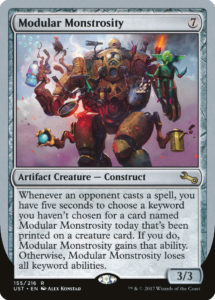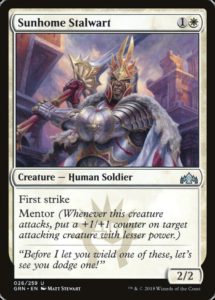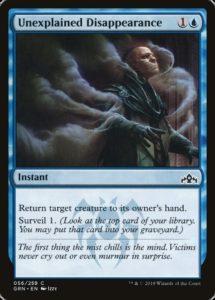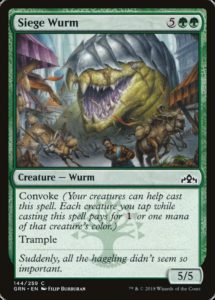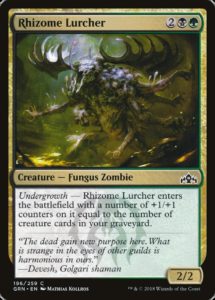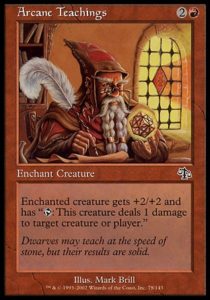Guilds of Ravnica has been out for just over a month now and the Pro Tour is come and gone. We’ve seen enough of the set to give it a thorough review, so we’ll do just that.
This article is the first of a three part Report Card series where we’ll review Guilds of Ravnica Limited. Today, we’ll scrutinize the mechanics, as I don’t think we can adequately review the archetypes and guilds without first grading their mechanics. In the second installment, we’ll test against the same six criteria we used to crown Dominaria as a masterpiece: Balance, Power, Archetypes/Synergy, Replayability, Fixing, and Interaction. In the final installment, we’ll give Guilds of Ravnica Limited its full report card, along with several suggestions for how things could have been tweaked.
With that, let’s jump right into Guilds of Ravnica’s mechanics!
Mechanics
We’ll be grading each mechanic in Guilds of Ravnica according to its design, utility, and play patterns. Basically, is the mechanic grokkable (intuitively understandable)? How is the play pattern? Does it support multiple play patterns? How is the mechanic used in the set? We’ll give each mechanic a letter grade. Obviously there is a degree of subjectivity to this, so while I may enjoy or dislike the design or implementation of a mechanic, you’re allowed to disagree or to like/dislike it in spite of my words. Magic is a game for many people, not just this one game designer.
Mentor
Magic has had a host of mechanics that encourage aggression. This makes sense—aggressive mechanics push the game towards a conclusion, whereas defensive ones like Banding, Absorb, Reach forestall the game’s end.
I love how Mentor encourages thinking about attacking in a new way. It creates a deckbuilding puzzle that encourages playing small creatures and paying attention to the relative size of your threats. It leads to snowballing (a small advantage compounding itself into a much larger advantage); but rather than allow a quick start to automatically win the game, it turns off once your creatures have learned everything they can from each other. Mentor is a refreshingly nuanced “attack attack attack!” mechanic, a splendidly designed mechanic.
The biggest issue with Mentor is that it can only go on certain kinds of creatures at common and uncommon. Mentor creatures tend to either top off at two power (making you have to work for Mentor to ever trigger) or have basically no toughness. The notable exception is Wojek Bodyguard, the set’s 2R 3/3 with downside (which, starting with Ixalan’s Headstrong Brute, also get upsides). There basically can’t be a common 2/2 Mentor because of how quickly it takes over a game with one drops or a single +1/+1 counter.
Mentor is a very cool new innovation. While it likely warps an entire format’s creature stats around itself, it is a fun puzzle to piece together in a color combination that tends not to get such mechanical puzzles.
Mentor Rating: A-
Surveil
Surveil is a mechanic that has everything working against it. It’s basically Scry, an evergreen workhorse mechanic that hasn’t ever been a build-around mechanic (barring two red uncommons in Theros block).
I’ve already gushed about how I think Surveil is brilliant, and I stand by my words. There are entire Surveil-matters decks that can exist. It has all sorts of mini-synergies with Jump-start, Undergrowth, and individual cards like Kraul Swarm. It’s a tricky mechanic that has a higher skill ceiling than Scry because it feels worse binning a card than bottom one (even though a skillful player recognizes the two are usually functionally identical). Best of all, Surveil feels like dangerous spycraft, where enacting your game plan can bring you to the brink of decking yourself. I feel like Wizards really pulled out all the stops to give Surveil its day despite being an underwhelming-looking mechanic, since it’s not replacing Scry.
Surveil is awesome. The biggest problem I have with it is that by needing to show up in such a high density, it makes the other mechanics seem scarce by comparison, but that’s really splitting hairs.
Surveil Rating: A+
Convoke
Convoke is back, and with the one exception of Venerated Loxodon, does not innovate. It has the same play pattern it had in Ravnica: City of Guilds, Magic 2015, and Modern Masters 2015: play cheap creatures to accelerate into more expensive threats. However, there are missing pieces. It has less support, notably lacking a midrange token-producing, Convoke-enabling threat (i.e. Scatter the Seeds or Triplicate Spirits). Moreover, there is no Inspired Charge to reward going wide, nor Populate or Selesnya Evangel to allow for token snowballing or shenanigans, nor Aristocrats-style way to sacrifice tokens for value like Golgari Rotwurm. Convoke has very few tools with which to work with beyond deploying expensive creatures.
Perhaps worst of all, Convoke is the only guild mechanic to not really play well with other mechanics: yes, it encourages playing creatures which fuel Undergrowth and its small creatures can be Mentored onto, but that’s basically it. Surveil directly interacts with Jump-start and Undergrowth, and Mentor benefits from red’s combat tricks and Jump-start spells, but Convoke doesn’t have any mechanical interaction beyond a creature-heavy deckbuilding constraint.
Convoke is a great mechanic, but it’s really disappointing seeing it basically diminished. It’s hard for a mechanic to innovate or remain interesting in a fourth appearance, and Convoke unfortunately does not.
Convoke Rating: D
Jump-start
Like Surveil, Jump-start has a disadvantage in being a clear twist on one of Magic’s best mechanics, Flashback. I think that Jump-start manages to succeed in having a different play pattern from its forebear, and not only that, but is also the first Izzet mechanic that really feels like conducting mad science.
Replicate and Overload weren’t mechanics that you could build a deck around. You had spells that could become stronger versions of themselves, whereas Jump-start lets you transmute one card into another. Moreover, all of Izzet is built around a spells-matter theme that has perhaps never been better supported, since your spells are designed to be cast twice.
To compare Jump-start to Flashback, Flashback is usually about card advantage, where you pay a minimal premium up-front and then later get a second (usually overcosted) spell for free. Jump-start spells have to cost the same amount each casting, but exist in a format where the very casting of a spell is rewarded. Goblin Electromancer was a fine, but not particularly important common when introduced in Return to Ravnica, but in Guilds of Ravnica, it is the linchpin around which all of Izzet chaotically coalesces. Jump-start is an excellent example of a simple twist on a mechanic where ample mechanical support turns it into something special, just like Surveil.
Jump-start Rating: A-
Undergrowth
Undergrowth is a scaling mechanic—every card bearing the mechanic has a variable effect based on the number of creatures in your graveyard. This presumably makes Undergrowth much harder to balance and design cards with, since there’s quite a high ceiling to how many creatures can be in a graveyard and the only cost that needs be played is a mana cost (well, and a deckbuilding cost).
Undergrowth has several interesting designs and is used in a variety of ways. Unfortunately, it has two major problems. First, it’s a graveyard mechanic, meaning it’s slow to enable and difficult to interact with. Second, it makes for decks that feel very similar to Selesnya (since both green guilds encourage playing as many creatures as possible). This cross-Guild synergy should be good, but in practice, it makes playing both guilds rather same-y as both guilds encourage playing below-rate creatures that mandate minimizing the number of noncreature spells in your deck. Undergrowth further suffers because the dearth of sacrifice effects and self-mill requires your opponent to cooperate by trading or killing your creatures; a Golgari mage with an uncooperative opponent is often stuck with little recourse.
Undergrowth is—well, it’s fine. It has all the problems of every other Golgari mechanic and suffers from a lack of support, because if it were supported, there’d need to be tons of graveyard hate, rendering it either unplayable or completely format-warping.
Undergrowth Rating: C-
Next time, Mechanics!
And that’s the five mechanics of GRN reviewed. The set does a pretty stellar job with three of its five mechanics, particularly considering two of them have such obvious antecedents. Unfortunately, Convoke is a pretty big miss, Undergrowth is fine but unexciting, and those two factors together do a lot to weaken green, as we’ll see next time in the Limited review. But until then, and as always, thanks for reading!
—Zachary Barash
Zachary Barash is a New York City-based game designer and the commissioner of Team Draft League. He designs for Kingdom Death: Monster, has a Game Design MFA from the NYU Game Center, and does freelance game design. When the stars align, he streams Magic.
His favorite card of the month is Vedalken Entrancer. It’s a grindy, grindy card, combining reasonable but unexciting stats with a weak ability that can nevertheless win the game. It functions slowly enough to not take over the game, but its combination of defense and inevitability make for a solid card without being broken.

